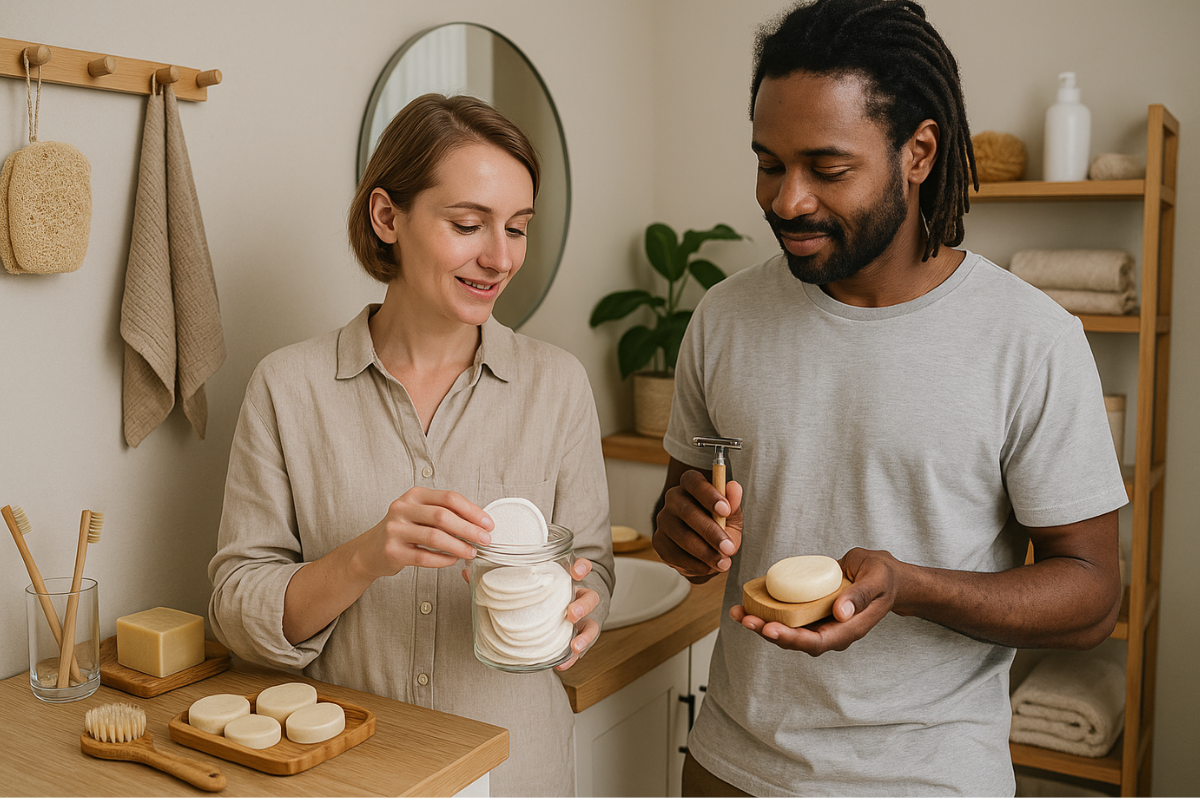When people think about reducing waste at home, they often overlook the bathroom. Yet it’s one of the rooms with the highest concentration of single-use plastic, disposable items, and chemical-laden products. The good news is that transforming your bathroom into a low-waste space is easier than you might expect.
Here’s how to build a more sustainable bathroom routine that’s gentle on the planet—and on you.
Why Focus on the Bathroom?
The average bathroom is filled with:
- Plastic bottles of shampoo, soap, and lotions
- Disposable razors and cotton rounds
- Over-packaged products
- Synthetic ingredients and microplastics
- Single-use wipes and pads
Replacing these items with more eco-friendly alternatives can drastically reduce your waste footprint.
Swap Disposable for Reusable
One of the simplest ways to lower your bathroom waste is to stop buying things that are meant to be thrown away.
Easy swaps:
| Disposable Item | Reusable Alternative |
|---|---|
| Cotton rounds | Washable fabric pads |
| Plastic razors | Stainless steel safety razor |
| Paper tissues | Reusable cloth handkerchiefs |
| Sanitary pads/tampons | Menstrual cup or reusable pads |
| Shower pouf | Natural loofah or washcloth |
These swaps are not only better for the environment, but also often more cost-effective over time.
Choose Solid, Package-Free Products
Solid bathroom products are usually long-lasting and come with little or no packaging.
Try these alternatives:
- Bar soap instead of body wash
- Shampoo and conditioner bars
- Solid lotion bars
- Toothpaste tablets
- Deodorant in compostable or refillable packaging
These items are also great for travel—no spills, no plastic, and no TSA issues.
Switch to Sustainable Materials
Plastic dominates most bathroom essentials, but there are more natural options available.
Greener materials include:
- Bamboo toothbrushes and combs
- Glass or metal containers for storage
- Wooden nail brushes
- Ceramic soap dishes
- Organic cotton towels and cloths
Choose products that are biodegradable or recyclable at the end of their life.
Use Products That Last
Many companies now offer refillable options for your everyday products.
Look for:
- Refillable shampoo, soap, and lotion bottles
- Concentrated cleaning pods or tablets
- Subscription-based refills for essentials
- Brands with take-back programs
Buying once and refilling reduces packaging waste significantly.
Simplify Your Skincare Routine
Skincare can be a big source of plastic and overconsumption. Minimalism can help both your skin and the planet.
Tips:
- Use multi-use products (like a balm for face, lips, and hands)
- Choose products in recyclable or returnable packaging
- Avoid products with microbeads or harsh chemicals
- Reduce the number of steps—stick to what your skin truly needs
Fewer products mean fewer emissions, less packaging, and less waste.
Ditch the Air Fresheners
Many commercial air fresheners are full of synthetic fragrances and come in non-recyclable packaging.
Natural alternatives:
- Essential oil diffusers
- Baking soda in a small jar
- Dried lavender or eucalyptus
- Open a window for fresh air!
You can keep your bathroom smelling fresh without compromising indoor air quality or the environment.
Think About Water Use Too
Being sustainable in the bathroom isn’t just about what you buy—it’s also about how you use resources.
Tips to save water:
- Turn off the tap while brushing teeth or shaving
- Take shorter showers
- Fix leaky faucets or running toilets
- Install a low-flow showerhead or dual-flush toilet
Water is a precious resource—every drop counts.
Involve the Whole Household
Make it easier for everyone to participate in your low-waste efforts.
- Label containers for refills
- Store reusable cloths in easy-to-reach places
- Keep a laundry bag for washable rounds or towels
- Talk about sustainability as a lifestyle, not a rule
The bathroom may be private, but sustainable habits can be shared.
Small Shifts, Big Impact
Your bathroom might be small, but the impact of changing your habits there can be huge. By removing single-use plastics, simplifying your routine, and choosing more sustainable materials, you’re taking powerful steps toward a greener home.
The goal isn’t perfection—it’s progress. And with every mindful choice, your bathroom becomes a space of care, calm, and conscious living.
